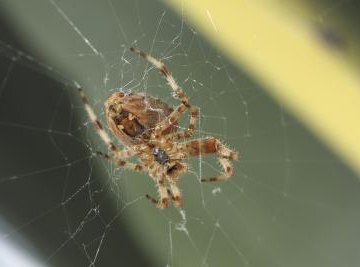
The difference between house spiders and brown recluses might seem difficult to determine at first, but a few quick tips can help you easily distinguish between the two. However, please remember that you should never handle any spider or other potentially dangerous animal unless you are absolutely certain of the species. When in doubt, it's best to leave the animal alone or contact a professional for removal.
Brown Recluse Range
Before diving into close inspections, the easiest way to determine the difference between house spiders and brown recluses is to see if brown recluses even live in your area. The range of the southern house spider, and other spider species, expands much farther than that of the brown recluse spider.
See the Entomology Today Range Map to determine if the brown recluse lives in your area.
Color Patterns & Markings
If you've checked and the brown recluse lives in your area, the next step is to look for the characteristic violin-shaped pattern on the cephalothorax, or the portion of the body that the spider's legs connect to. A brown recluse spider has a darker patch that is wider near the eyes and narrows like a violin as it moves towards the spider's abdomen. A house spider has no such pattern and is uniform in color on the cephalothorax.
It's important to note that though a house spider does not have a violin-shaped pattern, other spider species do have similarly shaped markings and the "violin" marking alone is not an accurate means of identifying a brown recluse spider.
Spider Webs & Behavior
If you're not quite sure about the markings, or you simply can't bring yourself to get that close to the spider to check, another good measure of the differences between house spiders and brown recluses is their general behavior. Though both types of spiders spin makeshift webs, they do so in different areas. The location of the web can help you determine the difference between a house spider and a brown recluse.
House spiders build their webs within tight crevices, and their webs haphazardly spread out from the opening in a disarrayed pattern. House spiders generally stay in or near their crevice, using their webs to catch prey. Brown recluses spend the daytime hiding beneath furniture or in closets and come out at night to hunt. You won't be able to spot a brown recluse web, as they spin theirs entirely out of sight and generally don't use it to catch prey.
Number of Eyes
If you're not close enough to look for a violin pattern, this tip likely won't be of much use to you! However, the best and most definitive way to identify a brown recluse, whether you're comparing it to a house spider or any other species, is by taking a very close look at their eyes. Granted, you will need some magnification to do so!
Unlike most spider species, brown recluse spiders only have six eyes. They have three pairs of eyes, which differs from most spiders who have eight eyes arranged in two rows of four. This not only helps you tell the difference between house spider and a brown recluse, but also helps you identify a brown recluse compared to most other species, as they are one of only a few species with six eyes.
The Danger Factor
Whether you've found a brown recluse or some other species of spider, the amount of danger that you are in is minimal. Though these spiders have garnered a poor reputation, the likelihood of a bite from one is quite low unless you are reaching under furniture or into dark areas blindly. They are not aggressive spiders and only bite to defend themselves.
Even if you are bitten, bites from this species generally do not present complications or extreme danger unless you are allergic or the bite becomes infected. You should seek medical assistance, but most treatment plans involve icing and elevating the bite, with an over-the-counter painkiller usually recommended.
References
Resources
About the Author
Marina Somma is a freelance writer and animal trainer. She holds a B.A. in Psychology and a B.S. in Marine and Environmental Biology & Policy from Monmouth University. Marina has worked with a number of publications involving animal science, behavior and training, including animals.net, SmallDogsAcademy and more.
Photo Credits
rickyblueblu/iStock/Getty Images
